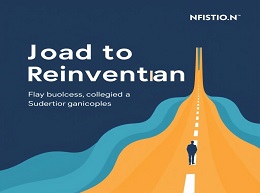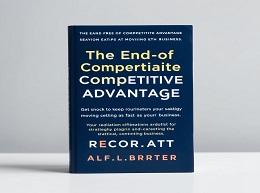Blue Ocean Shift: Beyond Competing - Proven Steps to Inspire Confidence and Seize New Growth

"Blue Ocean Shift: Beyond Competing - Proven Steps to Inspire Confidence and Seize New Growth" - A Comprehensive Review
"Blue Ocean Shift: Beyond Competing - Proven Steps to Inspire Confidence and Seize New Growth" by W. Chan Kim and Renée Mauborgne is a powerful follow-up to their groundbreaking book, "Blue Ocean Strategy." This book provides a practical roadmap for organizations seeking to move beyond competition and unlock new markets. With a blend of inspiring examples, actionable frameworks, and rigorous analysis, "Blue Ocean Shift" empowers leaders and teams to make the transformative shift from competing in crowded markets to creating new, uncontested market spaces.
The Essence of Blue Ocean Shift
Kim and Mauborgne begin by revisiting the core principles of the Blue Ocean Strategy, emphasizing the importance of creating "blue oceans" of uncontested market space, rather than battling in "red oceans" of fierce competition. "Blue Ocean Shift" builds on this foundation by offering a step-by-step guide for any organization looking to make the shift.
Understanding the Blue Ocean Shift Process
The authors outline a systematic process for making a Blue Ocean Shift, which includes understanding the current state, imagining a new market space, and making the strategic move. This process is broken down into five key steps, each designed to inspire confidence and guide organizations through the transition.
Step 1: Start Where You Are
The first step involves assessing the current state of your organization and market. This includes understanding where you stand in terms of competition and identifying the pain points within your industry.
Example: The book cites the example of CitizenM, a hotel chain that started by analyzing the frustrations of modern travelers. By understanding these pain points, CitizenM was able to reimagine the hotel experience, focusing on high-quality sleep and self-service check-in, thus creating a new market space within the hospitality industry.
Step 2: Understand Where You Could Be
Next, organizations need to visualize potential blue oceans. This involves identifying new opportunities that align with your strengths and capabilities, but are not constrained by current industry norms.
Example: One compelling case is that of Groupe SEB, a home appliance company. By identifying a new market for low-fat fryers, they created the ActiFry, which addressed health-conscious consumers' needs, leading to a significant new growth area.
Creating a Culture of Confidence
A critical component of the Blue Ocean Shift process is building a culture of confidence. Kim and Mauborgne emphasize that successful shifts are driven by a confident workforce that believes in the potential for growth and innovation.
Building Trust and Collaboration
To foster this culture, leaders must create an environment of trust and collaboration. This includes engaging employees in the process, encouraging their input, and valuing their contributions.
Example: In the case of the Malaysian government’s economic transformation program, the involvement of diverse stakeholders, including public servants and private sector leaders, fostered a collaborative environment that led to innovative solutions and new growth strategies.
Tools and Frameworks for Blue Ocean Shift
Kim and Mauborgne provide several practical tools and frameworks to support the Blue Ocean Shift process. These tools are designed to help organizations systematically explore new opportunities and develop strategies to capture them.
The Pioneer-Migrator-Settler Map
One such tool is the Pioneer-Migrator-Settler Map, which helps organizations categorize their products and services based on their growth potential. This map aids in identifying which offerings are pioneering new markets (Pioneers), which are migrating to new markets (Migrators), and which are settled in existing markets (Settlers).
Example: Apple’s transition from Settler products like desktop computers to Pioneer products like the iPod and iPhone demonstrates how the company continuously seeks new growth opportunities.
The Buyer Utility Map
Another valuable tool is the Buyer Utility Map, which helps organizations identify opportunities to unlock exceptional utility for buyers. This map highlights six stages of the buyer experience cycle and examines the utility levers at each stage.
Example: Kimberly-Clark used the Buyer Utility Map to develop Huggies Pull-Ups, focusing on the potty-training stage to create a new category in the diaper market that addressed a specific need for both parents and toddlers.
Overcoming Organizational Hurdles
One of the most significant challenges in making a Blue Ocean Shift is overcoming organizational inertia and resistance to change. Kim and Mauborgne address this by providing strategies to manage and overcome these hurdles.
Tipping Point Leadership
Tipping Point Leadership is a strategy that focuses on identifying and leveraging key influencers within an organization to drive change. By targeting and converting these influencers, leaders can create a tipping point that accelerates the shift towards new market opportunities.
Example: In the turnaround of New York City's police department, the then-Police Commissioner Bill Bratton used Tipping Point Leadership to address key pain points and mobilize the department’s resources towards reducing crime rates significantly.
Real-World Examples of Blue Ocean Shift
The book is rich with real-world examples of companies and organizations that have successfully made a Blue Ocean Shift. These case studies provide practical insights and inspiration for leaders looking to embark on their own journeys.
Cirque du Soleil
One of the most famous examples is Cirque du Soleil, which redefined the circus industry by combining elements of theater and dance, creating a new form of entertainment that appealed to a broader audience. By shifting focus from traditional circus elements like animal acts to a sophisticated blend of artistry and acrobatics, Cirque du Soleil created a blue ocean of uncontested market space.
Salesforce
Salesforce is another example of a successful Blue Ocean Shift. By moving away from traditional software sales and embracing a cloud-based subscription model, Salesforce revolutionized the CRM industry, offering unprecedented accessibility and scalability to businesses of all sizes.
The Impact of Blue Ocean Shift
"Blue Ocean Shift: Beyond Competing - Proven Steps to Inspire Confidence and Seize New Growth" is an essential read for leaders and organizations seeking to move beyond competition and unlock new growth opportunities. Kim and Mauborgne provide a comprehensive, actionable guide that combines strategic insights with practical tools and frameworks.
By following the steps outlined in the book, organizations can build a culture of confidence, overcome internal hurdles, and systematically explore new market opportunities. The real-world examples and case studies illustrate the transformative power of a Blue Ocean Shift, inspiring leaders to reimagine their industries and create uncontested market spaces.
Whether you are an established company looking to revitalize your growth strategy or a startup aiming to carve out a unique market niche, "Blue Ocean Shift" offers invaluable guidance for making the leap beyond competition and into new realms of possibility.













